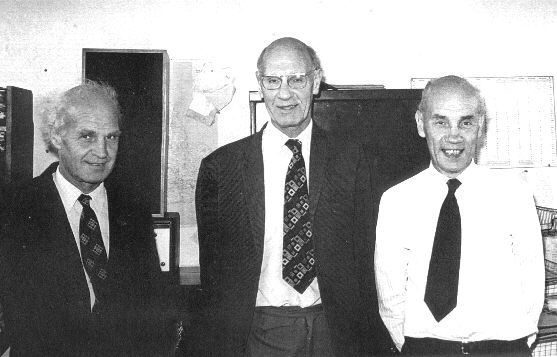The Mellotron and Streetly Electronics – a potted history
The story of the Mellotron begins in early 1962 when an American called Bill Fransen contacted a Midlands based engineering company called Bradmatic Ltd (run by three brothers Les, Frank and Norman Bradley) to see if they could produce seventy matched tape heads. The Bradleys went to see why someone would want all these tape heads and were shown an American keyboard instrument that had been made by Harry Chamberlin that replayed prerecorded tapes, one per key, of real instruments. It was the ‘Chamberlin’.

The Chamberlin, described as “a sideboard with keys on”, had many shortcomings but the Bradleys were “staggered” by the concept of a tape replay keyboard. The Chamberlin was also very difficult to produce in large numbers so the Bradleys refined and added their own innovations to the design and produced a new instrument that was named the Mellotron Mark I (The name came from MELOdy and elecTRONics but was finally spelt with two l’s).
By the end of 1962 financial backing was in place from some quite well known show business names such as David Nixon (TV magician) and Eric Robinson (Big Band leader, and supplier of many of the musicians who were recorded onto the tapes) and the factory in Streetly, Birmingham was opened.
The first Mellotron produced was the Mark I and was designed as a home instrument along the lines of an electronic organ. 55 were made in 1963.
The Mark I was quickly followed in 1964 by the improved Mark II. Most Mark I’s were converted to Mark II spec as well. Also having two 35 note (G – F) keyboards side by side it looked very similar. About 250 were made between 1964 and 1968.
An offshoot of the Mark II was produced for the BBC that was called the FX Console. It was a modified Mark II used for adding sound effects for radio and TV programmes (including Doctor Who). About 60 were made between 1965 and 1970. There was also an offshoot of the M400 used for the same purpose.
The M300 followed the Mark II and was the only production model that used 1/4″ tapes. Although Mark I and Mark II Mellotrons had already been used on quite a few albums in the late 60’s this was still produced as an alternative to the home organ. About 60 were produced between 1968 and 1970.
The M300 was followed by the most well known and successful model, the M400. By now Mellotronics had realised that the main customers for the instruments were rock bands so this was the most portable and oft-gigged version. About 2000 M400’s were produced between 1970 and 1986. This includes all Novatrons and the one-off teak flavoured batch of 100 produced by EMI in the mid seventies.

A variation on the 400 was the Mark V that was basically two 400’s side by side with a common capstan but only 30 were produced before disaster struck and the parent company Mellotronics went bust.
Two sad facts here, firstly Streetly who were actually producing the instruments were still financially sound and secondly, they were no longer allowed to call the instrument they produced ‘Mellotrons’. The reason for this is that the registered name ‘Mellotron’ was accidentally lost along with the other assets of the company ‘Mellotronics’. The M400 was quickly re-christened the ‘Novatron’ and was produced until the sad (but temporary) demise of Streetly Electronics in 1986.
Although originally designed as a ‘home entertainment’ keyboard by the mid sixties the Mellotron was starting to appear on contemporary rock / pop records. A few of the many users of note have included The Beatles, Yes (Rick Wakeman burnt his!), Genesis, Tangerine Dream, King Crimson, Moody Blues, Manfred Mann, Strawbs, Traffic, Led Zeppelin, Rolling Stones, Gentle Giant, Jethro Tull, Larry Fast (says he still has it), J M Jarre (recently seen on German TV with his M400 and is still touring with them), Barclay James Harvest, England, Pallas, Peter Sellers and (allegedly) Princess Margaret!
For most people the Mellotron finally faded into oblivion in the eighties, replaced by affordable solid-state samplers and sample replay keyboards. Mellotrons ended up being scrapped off or were left abandoned in squalid conditions in damp cellars and dusty storerooms.
However this is not the end of the story as the Mellotron has recently seen a revival in it’s fortunes in recent years. Quite a few fashionable people are starting to rediscover it’s unique sound (check out Oasis, Radiohead, Julian Cope and Node to name but a few). Sadly this has caused a considerable hike in the price of a Mellotron here in the UK so expect to pay at least 1500 pounds for an M400 (probably in dire need of repair) and about 4000 pounds for one that has been professionally restored by Streetly Electronics (restarted by John Bradley, Les Bradley’s son, who know all there is to know about Mellotrons).
However the story has taken a twist that even I couldn’t have forseen and that is I have been involved in the design of the next generation of instruments namely the Streetly M4000. Now available in limited numbers as the production process is still being developed. The reaction I have seen to the first fully working prototype has been extreme exitement, something you can lose sight of having worked on a project for a very long time.
I still have a Mellotron M400 after all these years and although I was tempted to sell it once during the ‘dark years’ I am glad that I retained my small piece of rock history.